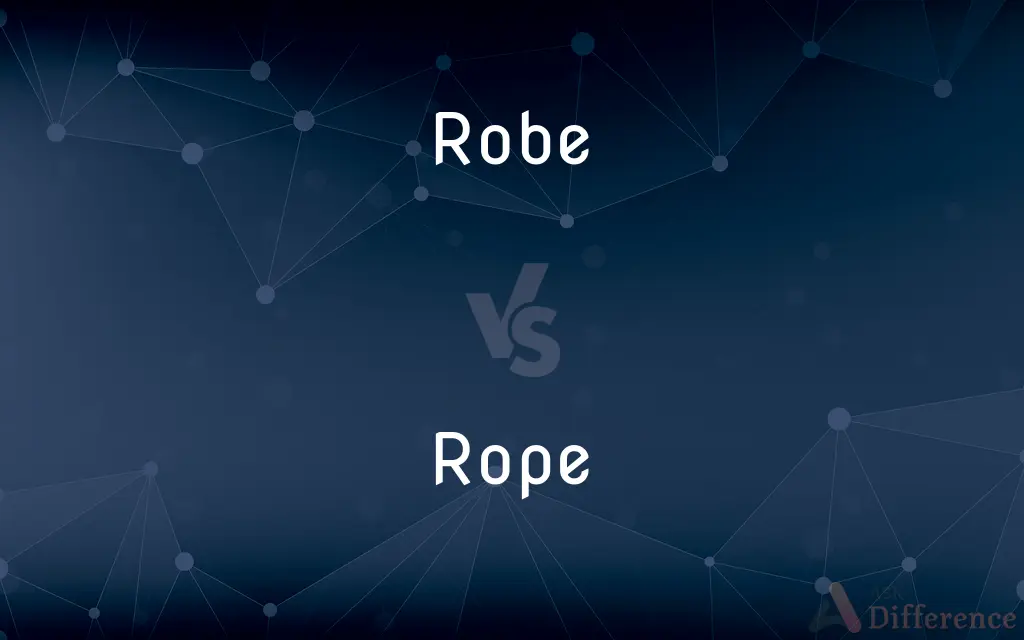Robe vs. Rope — What's the Difference?
By Tayyaba Rehman & Maham Liaqat — Updated on March 16, 2024
A robe is a long, loose outer garment worn for formal or ceremonial occasions or as comfortable loungewear, whereas rope is a long, thick cord made by twisting or braiding fibers or wires together, used for binding, pulling, or fastening.

Difference Between Robe and Rope
Table of Contents
ADVERTISEMENT
Key Differences
Robes are articles of clothing that vary in style, purpose, and material. They can be luxurious and made from silk or satin for formal wear, or soft and cozy, crafted from cotton or fleece for casual, at-home use. Robes provide warmth and privacy, often worn over nightwear or after bathing. On the other hand, ropes are utilitarian tools composed of natural fibers like hemp or cotton, synthetic fibers, or metal wires. Ropes serve numerous functions across different contexts, including construction, sports, and maritime activities, due to their strength and flexibility.
The significance of robes extends into cultural and religious domains, symbolizing status, authority, or specific roles within ceremonial practices. Judicial robes, for example, denote the office and authority of judges. Clerical robes worn by members of the clergy represent their spiritual roles. Conversely, ropes have historical and practical importance, with uses ranging from simple tasks like tying and securing objects to critical applications in safety equipment, climbing, and sailing. Ropes are valued for their tensile strength, durability, and versatility.
In terms of materials, robes are made from a wide variety of fabrics depending on their intended use. Luxurious robes might be made from silk or velvet, offering a sense of opulence and comfort. Everyday robes might be crafted from cotton or polyester, providing practicality and ease of care. Ropes, however, are made by twisting or braiding together strands of material to achieve the desired thickness and strength. Materials used in rope-making include natural fibers like sisal and manila, synthetic fibers such as nylon and polypropylene, and metals for wire ropes.
The design and construction of robes are focused on comfort, appearance, and sometimes symbolism. They may feature open fronts with belts or sashes for closure, and can include hoods, pockets, and decorative elements. Ropes, in contrast, are engineered for specific strengths, flexibilities, and resistances to environmental factors like water and sunlight. The construction process considers the rope's intended use, whether for lifting heavy loads, securing boats, or climbing.
Both robes and ropes have evolved over time, adapting to new materials, technologies, and societal needs. Robes have transitioned from traditional garments to modern loungewear and ceremonial attire, reflecting changes in fashion and cultural practices. Ropes have seen advancements in materials and manufacturing techniques, enhancing their strength, durability, and range of applications. Despite their distinct uses and contexts, both remain integral to human activities and cultural expressions.
ADVERTISEMENT
Comparison Chart
Definition
A long, loose outer garment
A long, thick cord made by twisting or braiding fibers together
Primary Use
Worn for comfort, formal or ceremonial occasions
Used for binding, pulling, or fastening
Material
Silk, satin, cotton, fleece, etc.
Hemp, cotton, nylon, polypropylene, wires, etc.
Cultural Significance
Symbolizes status, authority, or roles in ceremonies
Historical and practical importance in various fields
Design/Construction
Open front with belt, may include hoods and pockets
Twisted or braided strands for strength and flexibility
Compare with Definitions
Robe
Made from materials like silk, cotton, or fleece.
His luxurious silk robe was reserved for special occasions.
Rope
Made from natural or synthetic fibers, or metal wires.
The climbers relied on their sturdy hemp rope for safety.
Robe
Often used in religious or ceremonial contexts.
The priest donned his ceremonial robe for the service.
Rope
Has seen technological advancements.
Modern synthetic ropes offer greater durability and resistance to elements.
Robe
Can signify authority or status.
The judge's robe symbolized his authority in the courtroom.
Rope
Essential in various activities and industries.
The construction team used rope to hoist materials to the upper floors.
Robe
A garment worn for warmth and privacy.
She wrapped herself in a fleece robe after her bath.
Rope
Valued for its strength and flexibility.
The rope bridge, although swaying, was strong enough to cross.
Robe
Varies in style and purpose.
Her velvet evening robe was a statement of elegance and comfort.
Rope
Used for securing, lifting, or pulling objects.
They used a nylon rope to secure the boat to the dock.
Robe
A robe is a loose-fitting outer garment. Unlike garments described as capes or cloaks, robes usually have sleeves.
Rope
A rope is a group of yarns, plies, fibers or strands that are twisted or braided together into a larger and stronger form. Ropes have tensile strength and so can be used for dragging and lifting.
Robe
A long, loose outer garment reaching to the ankles
A baby in christening robes
A young man in a fez and ragged robe
Rope
A flexible heavy cord of tightly intertwined hemp or other fiber.
Robe
Short for lap robe
Rope
A string of items attached in one line, especially by twisting or braiding
A rope of onions.
Robe
Clothe in a robe
A circle of robed figures
A white-robed Bedouin
Rope
A sticky glutinous formation of stringy matter in a liquid.
Robe
Often robes An official garment worn on formal occasions to show office or rank, as by a judge or high church official.
Rope
A cord with a noose at one end for hanging a person.
Robe
An academic gown.
Rope
A lasso or lariat.
Robe
A dressing gown or bathrobe.
Rope
Ropes(Sports) Several cords strung between poles to enclose a boxing or wrestling ring.
Robe
Robes Clothes; apparel.
Rope
Ropes(Informal) Specialized procedures or details
Learn the ropes.
Know the ropes.
Robe
A blanket or covering made of material, such as fur or cloth
A lap robe.
Rope
(Baseball) A line drive.
Robe
To cover or dress in a robe or in something that functions like a robe
Fields that were robed with snow.
Rope
To tie, fasten, or attach with a rope or other cord.
Robe
To put on a robe or robes.
Rope
To enclose, separate, or partition with a rope or other cord
Rope off the scene of the crime.
Robe
A long loose outer garment, often signifying honorary stature.
Rope
To catch with a rope or lasso.
Robe
(US) The skin of an animal, especially the bison, dressed with the fur on, and used as a wrap.
Rope
(Informal) To persuade or manipulate (someone)
My boss roped me into attending the ceremony.
Robe
A wardrobe, especially one built into a bedroom.
Rope
(uncountable) Thick strings, yarn, monofilaments, metal wires, or strands of other cordage that are twisted together to form a stronger line.
Nylon rope is usually stronger than similar rope made of plant fibers.
Robe
The largest and strongest tobacco leaves.
Rope
(countable) An individual length of such material.
The swinging bridge is constructed of 40 logs and 30 ropes.
Robe
(transitive) To clothe; to dress.
Rope
A cohesive strand of something.
The duchess wore a rope of pearls to the soirée.
Robe
(intransitive) To put on official vestments.
Rope
A shot of semen that a man releases during ejaculation.
Robe
An outer garment; a dress of a rich, flowing, and elegant style or make; hence, a dress of state, rank, office, or the like.
Through tattered clothes small vices do appear;Robes and furred gowns hide all.
Rope
(dated) A continuous stream.
Robe
A skin of an animal, especially, a skin of the bison, dressed with the fur on, and used as a wrap.
Rope
(baseball) A hard line drive.
He hit a rope past third and into the corner.
Robe
To invest with a robe or robes; to dress; to array; as, fields robed with green.
The sage Chaldeans robed in white appeared.
Such was his power over the expression of his countenance, that he could in an instant shake off the sternness of winter, and robe it in the brightest smiles of spring.
Rope
(ceramics) A long thin segment of soft clay, either extruded or formed by hand.
Robe
Any loose flowing garment
Rope
(computer science) A data structure resembling a string, using a concatenation tree in which each leaf represents a character.
Robe
Outerwear consisting of a long flowing garment used for official or ceremonial occasions
Rope
A kind of chaff material dropped to interfere with radar consisting of foil strips with paper chutes attached.
Robe
Clothe formally; especially in ecclesiastical robes
Rope
(Jainism) A unit of distance equivalent to the distance covered in six months by a god flying at ten million miles per second.
Rope
(jewelry) A necklace of at least 1 meter in length.
Rope
(nautical) Cordage of at least 1 inch in diameter, or a length of such cordage.
Rope
(archaic) A unit of length equal to 20 feet.
Rope
(slang) Rohypnol.
Rope
Semen being ejaculated.
Rope
(in the plural) The small intestines.
The ropes of birds
Rope
(transitive) To tie (something) with rope.
The robber roped the victims.
Rope
(transitive) To throw a rope (or something similar, e.g. a lasso, cable, wire, etc.) around (something).
The cowboy roped the calf.
Rope
(intransitive) To climb by means of a rope or ropes.
Rope
(intransitive) To be formed into rope; to draw out or extend into a filament or thread.
Rope
To commit suicide, particularly by hanging.
My life is a mess; I might as well rope.
Rope
A large, stout cord, usually one not less than an inch in circumference, made of strands twisted or braided together. It differs from cord, line, and string, only in its size. See Cordage.
Rope
A row or string consisting of a number of things united, as by braiding, twining, etc.; as, a rope of onions.
Rope
The small intestines; as, the ropes of birds.
Rope
To be formed into rope; to draw out or extend into a filament or thread, as by means of any glutinous or adhesive quality.
Let us not hang like ropingiciclesUpon our houses' thatch.
Rope
To bind, fasten, or tie with a rope or cord; as, to rope a bale of goods.
Rope
To connect or fasten together, as a party of mountain climbers, with a rope.
Rope
To partition, separate, or divide off, by means of a rope, so as to include or exclude something; as, to rope in, or rope off, a plot of ground; to rope out a crowd.
Rope
To lasso (a steer, horse).
Rope
To draw, as with a rope; to entice; to inveigle; to decoy; as, to rope in customers or voters.
Rope
To prevent from winning (as a horse), by pulling or curbing.
Rope
A strong line
Rope
Street names for flunitrazepan
Rope
Catch with a lasso;
Rope cows
Rope
Fasten with a rope;
Rope the bag securely
Common Curiosities
How are ropes made?
Ropes are made by twisting or braiding together strands of natural fibers, synthetic fibers, or metal wires.
What materials are robes made from?
Robes can be made from silk, satin, cotton, fleece, and other materials for different levels of comfort and formality.
What are the environmental considerations for rope manufacturing?
Environmental considerations include the sustainability of raw materials and the impact of synthetic fibers on ecosystems.
Can robes be part of professional attire?
Yes, robes can be part of professional attire in certain contexts, like judicial robes in courtrooms.
Can robes have symbolic meanings?
Yes, robes can symbolize status, authority, or specific roles within cultural, religious, and ceremonial contexts.
What are the primary uses of rope?
Rope is primarily used for binding, pulling, fastening, climbing, and in various industrial and recreational activities.
How do the materials of robes and ropes differ?
Robes are made from a wide range of fabrics for comfort and aesthetics, whereas ropes are made from materials selected for strength, durability, and flexibility.
Can robes be casual wear?
Yes, many robes are designed for casual, at-home wear, offering comfort and ease after bathing or during leisure time.
Are robes worn for specific occasions?
Yes, robes can be worn for comfort at home, as part of formal attire, or during ceremonial events.
What industries rely on rope?
Construction, maritime, climbing, sports, and many other industries rely on ropes for various tasks.
What advancements have been made in rope technology?
Advances in materials and manufacturing have led to ropes with greater strength, durability, and specific properties like resistance to water and UV light.
How has the design of robes evolved?
The design of robes has evolved to reflect changes in fashion, cultural practices, and materials.
How do ropes contribute to safety?
Ropes contribute to safety in climbing, maritime activities, and construction by securing equipment and people.
Do robes have closures?
Robes typically feature open fronts with belts or sashes for closure, allowing for adjustable fit.
Are all ropes flexible?
Flexibility varies among ropes, depending on their construction and the materials used, to suit specific applications.
Share Your Discovery

Previous Comparison
Attendant vs. Waiter
Next Comparison
Size vs. ValueAuthor Spotlight
Written by
Tayyaba RehmanTayyaba Rehman is a distinguished writer, currently serving as a primary contributor to askdifference.com. As a researcher in semantics and etymology, Tayyaba's passion for the complexity of languages and their distinctions has found a perfect home on the platform. Tayyaba delves into the intricacies of language, distinguishing between commonly confused words and phrases, thereby providing clarity for readers worldwide.
Co-written by
Maham Liaqat













































